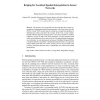Free Online Productivity Tools
i2Speak
i2Symbol
i2OCR
iTex2Img
iWeb2Print
iWeb2Shot
i2Type
iPdf2Split
iPdf2Merge
i2Bopomofo
i2Arabic
i2Style
i2Image
i2PDF
iLatex2Rtf
Sci2ools
SSDBM
2008
IEEE
2008
IEEE
Kriging for Localized Spatial Interpolation in Sensor Networks
Abstract. The presence of coverage holes can adversely affect the accurate representation of natural phenomena being monitored by a Wireless Sensor Network (WSN). Current WSN research aims at solving the coverage holes problem by deploying new nodes to maximize the coverage. In this work, we take a fundamentally different approach and argue that it is not always possible to maintain exhaustive coverage in large scale WSNs and hence coverage strategies based solely on the deployment of new nodes may fail. We suggest spatial interpolation as an alternative to node deployment and present Distributed Kriging (DISK), a localized method to interpolate a spatial phenomenon inside a coverage hole using available nodal data. We test the accuracy and cost of our scheme with extensive simulations and show that it is significantly more efficient than global interpolations. Key words: Wireless Sensor Networks, Coverage Holes, Interpolation, Kriging
| Added | 01 Jun 2010 |
| Updated | 01 Jun 2010 |
| Type | Conference |
| Year | 2008 |
| Where | SSDBM |
| Authors | Muhammad Umer, Lars Kulik, Egemen Tanin |
Comments (0)

